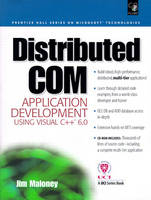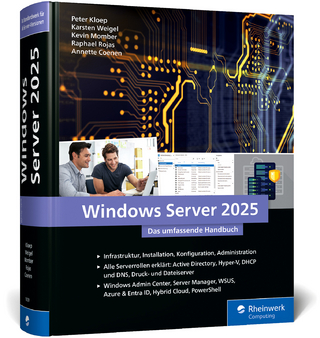
Distributed COM Application Development Using Visual C++ 6.0
Prentice Hall (Verlag)
978-0-13-084874-1 (ISBN)
- Titel ist leider vergriffen;
keine Neuauflage - Artikel merken
PLEASE PROVIDE
This book gives intermediate-to-advanced Visual C++ and MFC programmers all the in-depth knowledge and skills they need to build and deploy state-of-the-art multi-tiered applications. Expert developer Jim Maloney helps developers master every key technology involved, including COM/DCOM, MTS, ADO, and OLE DB. Begin with a clear overview of multi-tier development in Microsoft environments: the goals and the challenges, including avoiding network bottlenecks. Then, master multi-tier development by building a robust, three-tier application. Review using objects in Visual C++ applications; then learn how to implement Win32 presentation layer clients and develop applications that run over TCP/IP. Understand database access using ActiveX Data Objects (ADO); implement an ActiveX-based object model; and learn the key fundamentals of DCOM, step-by-step. Use Microsoft Transaction Server (MTS) to implement your application's data service layer; build Web interfaces with Active Server Pages (ASP); deploy your application with Internet Information Server (IIS4), and much more.
Jim Maloney is a consultant with UCI Corporation and a practicing MCSD.
1. Deploying a Multi-Tiered Client/Server Application.
Application Architectures. Desktop Application Architecture Overview. 2-Tier Application Architecture Overview. 3-Tier Application Architecture Overview. N-Tier Application Architecture Overview. About 2-Tier Client/Server Applications. Physical Deployment of 2-Tier Client/Server Applications. About 3-Tier Client/Server Applications. Physical Deployment of 3-Tier Client/Server Applications. About the Object Model. Building a Suite of Applications. The Legacy Systems of Tomorrow. Deploying the Sample Application. Deploying a 3-Tier Client/Server Application. Deploying the Mom-n-Pop Video Store Application.
2. Using COM Objects in an Object Model.
About Objects. About the Visual Basic Programming Language. Objects and Programming. Understanding an Object Model. The Mom-n-Pop Video Store Object Model. Stateful Objects and Transactions. Business-Focused Design. Candidate Solutions for State and Transactions. Standard COM Types. Unicode and BSTR Strings. Win32 Functions Related to BSTR Types. Using the CURRENCY Type. COM Data Type Conversion Functions. Using Variant Types. Working with Safe Arrays. Checking for Errors in a COM Application. Walkthrough—Using an Object Model. Creating a Dialog Application with the AppWizard. Adding Code to Initialize COM. Importing the Type Library. Adding a List Box to Display Members. Displaying Members in the List Box. A Closer Analysis of the UI Code.
3. Database Access Using OLE DB.
What is OLE DB? About the Demonstration Programs. Using OLE DB Interfaces. About the First OLE DB Sample Program. Initializing a Data Source. Creating a Session on the Data Source. Command Objects. About OLE DB Rowset Objects. About OLE DB Accessors. Closing Comments on the First Example. Parameterized Queries with OLE DB. About the Second OLE DB Sample Application. Creating a Parameterized Command. Binding Parameters. Executing a Command with Parameters. Updating Data Using Parameterized Commands. Performing Transactions with OLE DB Interfaces. About the ITransactionLocal Interface. Isolation Levels and the StartTransaction Method. Zombie Rowsets. Transaction Retention. The OLE DB Transaction Demo Program. Using OLE DB Service Components. Opening a Data Source with MDAC. Using a Connection String. Using OLE DB Templates. Introducing the OLE DB Template Classes. The CDataSource and CDBPropSet Classes. The CSession Class. The CCommand and CAccessor Template Classes. Opening a Rowset Using CCommand. Retrieving Rows Using OLE DB Templates. Closing the Data Source, Session, and Rowset. Generating a CRowset Class Using the ATL Object Wizard. Parameterized Queries with OLE DB Templates. Executing a Parameterized Query with OLE DB Templates. Providing Parameter Binding Information. Supplying Parameter Values. Updating Data with OLE DB Templates. Transactions and the OLE DB Template Classes. Service Components and the OLE DB Templates. Connection Strings and OLE DB Templates. ADO Recordset and OLE DB Rowset Equivalences. Converting a Rowset to a Recordset. Converting a Recordset to a Rowset. Using the Data Link API. The Data Link Properties Dialog. Using the COleDBRecordView Class. A Simple COleDBRecordView Application. Generating A Simple COleDBRecordView Application. AppWizard-Generated Classes for OLE DB Record Views. Providing Controls for Database Columns. Adding an Update Now Button. A Full-Featured OLE DB Record View Application. Using Multiple Accessors. Adding New Records Using COleDBRecordView. Deleting a Record Using COleDBRecordView. Rowset Navigation Using Bookmarks.
4. Database Access with ADO.
ADO and OLE DB. Problems Solved by ADO and OLE DB. ADO or OLE DB? The ADO Object Model. The ADO Connection Object. The ConnectionString Property. About the First ADO Demo. Importing the ADO Type Library. Connecting to a Database Using ADO. The Connection Object's Mode Property. Example: Connecting to a Database Using ADO. The ADO Recordset Object. About ADO Recordset Cursors. Opening a Recordset Using ADO. Example: Opening a Recordset. Accessing Fields in a Recordset. Scrolling through a Recordset Using Move Methods. Requerying and Resynching Recordsets. Using ADO Recordset Binding. Using the CADORecordBinding Class. Providing Binding Information to ADO. Retrieving Data From Bound Recordsets. Using ADO Command Objects. Building an SQL SELECT Statement. ADO Command Objects and Parameterized Queries. Using Multiple ADO Parameters in a Command. Retrieving Multiple Rows with the GetRows Method. Working with Transactions Using ADO. Updating Records in a Recordset. Mom-n-Pop Video Store Case Studies. Retrieving the Late Fee from the Database. Searching for a Member by Last Name. Invoking a Stored Procedure.
5. Implementing an Object Model.
A Review of COM Servers. In-Process and Out-of-Process COM Servers. Setting Up an In-Process COM Server Project. The User Interface Test Project. Implementing a Simple Object Model. Goals of the First Simple Object Model. Creating the ATL Project. Enabling ATL Trace Information. Creating the ATL Objects. Exploring Code Generated by the ATL Wizard. Top-Level Objects and the Appobject Attribute. Noncreateable Public COM Classes. Objects That Participate in Collection Implementation. Types of Collections. Implementing the Category Class. Implementing the Categories Collection. Designating a Default Property. Adding a Collection Access Property. Testing the Object Model from Visual Basic. Providing a Friendly Description for the Type Library. Creating and Using COM Enumerators. Persistent Collections and ATL Stock Enumerators. Using the ATL Stock Enumerator. Supporting Empty Collections with CComEnum. Collections Built from Query Results. Accessing a Database to Create a Collection. Variant Parameters for the Item Method. Supporting the ISupportErrorInfo Interface. Object Models in 3-Tier Architectures. Case Studies from the Mom-n-Pop Object Model. Background. Accessing the Categories Collection.
6. Introducing DCOM.
About DCOM. Services Provided by DCOM. OSF/DCE and Remote Procedure Calls. Before Getting Started with DCOM. A DCOM Walkthrough. Server-Side COM Registry Entries for Local Servers. Client-Side DCOM Registry Entries for Remote Servers. Using a Surrogate for Hosting a Remote In-Process Server. Setting up a DCOM Server Project. Implementing and Building the Server. Implementing a Test Client Program: User Interface. Running the Server Remotely. Permission Error. Using CoCreateInstanceEx. Troubleshooting DCOM Problems. Using the Error Lookup Utility. Using the Event Viewer.
7. Introducing Microsoft Transaction Server.
About MTS. The MTS Run-Time Environment. About the MTS Explorer Utility. MTS Packages and Components. Creating an MTS Package. Installing an MTS Component into a Package. Running and Monitoring MTS Components. Enabling Just-in-Time Activation. The MTS API. About the IObjectContext Interface. Connection Pooling. Using the IObjectContext Interface. MTS Component Restrictions. Transactions in MTS. MTS Components and Transaction Outcome. Transaction Attributes of an MTS Component. Stateful and Stateless MTS Objects. 2-Tier in Disguise. Just-in-Time Activation. Implementing the IObjectControl Interface. MTS Transaction Support Demo. Debugging MTS Components. The MTS Shared Property Manager. The CreatePropertyGroup Method. Thread-Safe References to Shared Properties. Shared Property Manager Demo. Deploying MTS Servers. Security and MTS. About MTSDemo4 — The MTS Security Demo. MTS Package Identity is Your First Line of Defense. Declarative Security — Your Second Line of Defense. Defining an MTS Role. Enabling Package Authentication for Declarative Security. Assigning NT User Accounts to MTS Roles. How Programmatic Security Works. Determining Whether Security Is Enabled. Using the IsCallerInRole Method.
8. Implementing the Data Service Layer with MTS.
Requirements for MTS Components. MTS Components Implement Business Rules. The Role of Stored Procedures. Be Business-Focused. Each Layer Adds Value. Mom-n-Pop MTS Components. The MemberData MTS Component. The VideoData MTS Component. The PointOfSale MTS Component. Case Study: Using the Shared Property Manager. Object Interaction Scenario — Finding a Member by ID.
9. Creating an Internet Interface with Active Server Pages.
About Active Server Pages. The Mom-n-Pop Web Site Demo. Creating Active Server Pages. Adding Script Commands to ASP Pages. The ASP Built-In Objects. Declaring and Using Variables in ASP Scripts. Sending Content to the Browser. HTML Forms and the Request Object. Creating Objects in ASP Script. Processing Recordsets in ASP Scripts.
Index.
| Erscheint lt. Verlag | 26.11.1999 |
|---|---|
| Verlagsort | Upper Saddle River |
| Sprache | englisch |
| Maße | 175 x 235 mm |
| Gewicht | 845 g |
| Themenwelt | Informatik ► Betriebssysteme / Server ► Windows |
| Mathematik / Informatik ► Informatik ► Programmiersprachen / -werkzeuge | |
| ISBN-10 | 0-13-084874-3 / 0130848743 |
| ISBN-13 | 978-0-13-084874-1 / 9780130848741 |
| Zustand | Neuware |
| Informationen gemäß Produktsicherheitsverordnung (GPSR) | |
| Haben Sie eine Frage zum Produkt? |
aus dem Bereich


